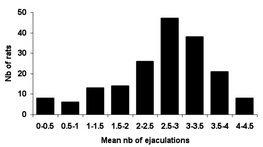Ejaculatory disorders
Background
As originally proposed by Beach, (1956), male sexual behavior can be divided into a minimum of two conceptually distinct components, an appetitive/motivation and a consummatory/performance component. Appetitive behaviors/motivation directs the male to search and approach a sexually receptive female. The consummatory behavior/performance refers to copulation including mounts, intromissions, and ejaculations. When placing a male rat with a sexually receptive female, male mounts the female from the rear, palpates her flanks with the forelegs and thrusts his penis rapidly and repeatedly. If no penile insertion occurs the act is referred to as a mount otherwise, if mount results in penile insertion the act is called intromission. After a number of intromissions the male mounts again, gains penile insertion and ejaculates sperm in the form of a coagulated “plug” into the vagina. After ejaculation, there is a sexual refractory period with no copulatory activity and the time from ejaculation to the next sexual act is called the post-ejaculatory interval.
Ejaculatory disorders in men, and more particularly premature ejaculation, are the most common male sexual dysfunctions yet they remain under-diagnosed and under-treated. In men, biological variation of the intravaginal ejaculation latency time has been observed which follows a Gaussian distribution. Accordingly, there are men who have short ejaculation latency time referred as premature ejaculation, others retarded ejaculation, and a last category of men who ejaculate in a range of “normal” ejaculation time. Interestingly, a similar distribution of ejaculation latency has been described in male rats, thus giving the opportunity to use a relevant animal model of ejaculatory disorders for pre-clinical researches.
Model description
From standardized mating tests with sexually receptive female rats conducted in our laboratory, the number of ejaculations was found to follow a Gaussian distribution (figure 1). On one side of the curve approximately 11 % of rats displayed “hypo-sexual” activity (< 1 ejaculation in average) and on the other side 13 % displayed “hyper-sexual” behaviour (> 3.75 ejaculations in average) after at least 4 successive 30 min mating tests performed in unilevel chamber. The bilevel chamber paradigm can also be used for distinguishing the different male rat populations. Interesting differences were found between the three different groups of male rats on a variety of other parameters of sexual behaviour, resembling clinical signs of men complaining with retarded or premature ejaculation. Compared to “normal” rats, ejaculation latency was shorter in “hyper-sexual” or “rapid” rats and longer in “hypo-sexual” or “sluggish” animals. Intromission and mount frequencies, the latter being considered as a putative index of sexual motivation, did not differ between the 3 categories of male rats, suggesting no difference in appetitive components of sexual behaviour. Such a procedure allows the selection of different categories of male rats representative of the human conditions for their use in various experimental paradigms.
 |
| Figure 1: Histogram of the ejaculation frequency in 125 male Wistar rats tested in unilevel chamber (Pelvipharm, internal data). |
Bibliographic references :
Beach FA (1956). Characteristics of masculine “sex drive”. In Jones MR, editor. Nebraska Symposium on motivation. Lincoln, NE: University of Nebraska Press, p 1-32.
J Sex Med (2009) : 6(8):2197-205

Links to applicable Experimental skills
- Administration routes / Regimen
- Behavioural Science
- Confocal Microscopy
- Ejaculation
- Ejaculation elicited by pharmacological or electrical neural stimulation
- Electrophysiology
- Immunohistology
- Neural firing recording
- Neuro-anatomical tracing techniques
- Organ bath with animal tissues (In Vitro studies)
- Organ bath with human tissues (In Vitro studies)
- Oxidative fluorescence
- Plasma / urine / tissue collection
- Protein expression and activity
- Spectrophotometric assays





















 Download this page in PDF
Download this page in PDF